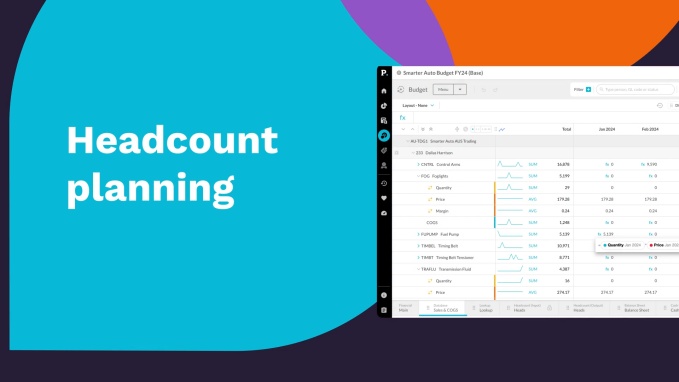Align headcount planning and forecasting with your budget strategy

Remuneration is one of the highest and most complex costs in an organization. So, it’s essential that finance and other business partners especially those in human resources (HR) align current and future talent costs with strategic goals across an organization . That’s where headcount planning is crucial for ensuring efficient resource allocation. When integrated with your budget and your workforce planning, you can factor in skills gaps in the current workforce, as well as business goals, to plan who needs to be recruited when and related costs.
Headcount planning involves testing out your strategy with your existing organizational structure and then making recruitment adjustments so the business can meet all short and long term objectives.
HR managers need to ensure that salary packages are fair and in line with the market as well as determine whether they are affordable to the business. Headcount planning also helps HR teams to structure more individually focused salary packages and test their financial validity.
The time and human effort associated with headcount planning can vary based on the complexity of the process, the size of your organization, and the thoroughness of your planning. Developing a comprehensive headcount plan requires time and effort but there are shortcuts if you have access to strong data. Headcount planning can be done holistically and include data analysis, forecasting, and alignment with organizational goals when using a business planning and analytics platform like Phocas rather than spreadsheets.
By understanding the pressures on both teams, greater communication emerges between finance and human resources, helping everyone work to the same goals. So often, the human resources team represents the interest of the workers, and the finance team looks after the organization's overall financial health. When the headcount planning process is robust both parties can readily see the needs of both and make more holistic decisions.
Phocas Budgets and Forecasts includes the headcount driver feature to assist finance teams to integrate human resources metrics within the business budget model development.
In the budget workbook in Phocas, Finance can use the headcount tab that includes all your fixed and variable staff costs for the number of employees (salary, bonus, commission) plus the related benefit costs that are pulled directly from your HRIS system. These current headcount expenses are the foundation of every business budget, so they need to be accurate. Finance can budget in detail with department heads for all existing full-time staff and new employees and leavers. All stakeholders require talent forecast information to plan for future recruitment so have restricted access to the salaries affecting their branch, team or division so all this confidential headcount data is available only to the relevant hiring managers.
“The tool simplifies the headcount planning process. Finance can manage talent planning all year round so they can account for bonus payments, plan for merit pay and plan for new hires and it all feeds back into the remuneration figures in the master budget."
Dan Harrison, Chartered Accountant and Subject-matter expert for Phocas Budgets and Forecasts.
The benefit of the headcount driver is that when a change to one formula is made, this integrates across the entire process and where several remuneration plans are built, the headcount driver can differentiate automatic updates in one region only (for example, updates to superannuation payments for Australia). The tool is useful for companies who have a global workforce with different compensation and benefits structures depending on the employment laws in each country.
The headcount driver can be used across industries and built to match your needs. For example, in sales organizations with intricate pay models where some benefits are based on percentages of salary, or a manufacturing business where the number of production employees is directly dependent on sales budgets. All these structures can be accommodated within the headcount driver tool in real-time.
In most sales organizations, compensation is varied. When people are selling complex products, there are more factors a company can use to measure and incentivize its sales team, such as customer retention, customer satisfaction and profitability per customer. However, creating staffing models linked to these drivers can be time-consuming and tedious to update without the right software. As a result, people often spend too much time on detail rather than looking at the big picture.
You can also build-in headcount forecasting or demand forecasting of your workforce by including data points for accurate headcount for the entire year. This means the template can cater for future needs or new hires in 6 or 9 months from when the budget model is set. This helps the HR team make informed decisions in hiring plans and can help business partners get the right skills to realistically achieve the business strategy.
Using a dynamic business planning and analytics platform, the finance team can align any of these measures to the individual salesperson and link to any cost line in the profit and loss using the headcount driver.
In this video below you can quickly learn how effective headcount planning can take shape in the headcount model. The dynamic model can also manage structuring remuneration around EBITDA versus top-line revenue. This model is most useful when the salesperson can directly influence their sales profitability by setting the price and margin and adjusting costs. With the proper access to data, this sophisticated model is a real incentive for salespeople to manage their customers and enhance their bonus payment effectively.

All your labor costs are included for the number of people you think you need to match for your business needs. When all the costs for staffing needs are mapped out in a dashboard, everyone can see the revenue required to support a workforce of this size and calibre. If you can’t afford to manage this amount of people, you can work with the area managers to decide on the critical roles and avoid layoffs down the track because you have completed this level of strategic workforce planning. It allows you to do the restructuring in the model rather than down the track in real life, making everyone feel secure and ensuring the right skills sets are in your team.
Compensation and bonus payments are sensitive information, so the budget owner can streamline permissions allowing only the line managers to see their people’s information and be able to make key decisions about their workforce data.
Phocas aims to also give finance peace of mind that they can set up HR data automation or upload directly from Excel and this data is stored with confidence in the cloud. The 256-bit RSA-OAEP public key encryption has been used to ensure the sensitive information is highly secure.
As businesses globally continue to grapple with the scarcity of talent and the need to offer competitive salaries and benefits, the need to manage and forecast a remuneration strategy is paramount. The headcount driver feature in Phocas Business Planning and Analytics brings headcount planning into your budget process so it is linked to your strategy deliverables. This level of workforce management allows your business to stays on top of its cash flow and ensure retention of the right talent.
For more information about the Phocas live budgets and forecasts, download the free eBook: Companywide financial planning and analysis

Katrina is a professional writer with a decade of experience in business and tech. She explains how data can work for business people and finance teams without all the tech jargon.
Related blog posts

Agility is everything in manufacturing, distribution and retail businesses. Finance teams are under constant pressure to deliver accurate forecasts, accelerate the planning cycle and to have actuals at hand so everyone knows how they’re tracking. For businesses running NetSuite ERP, this means their budgeting and forecasting tools must be up to the task.
Read more
Inventory management is a tight-rope balancing act. Ordering too much leaves you with excess stock tying up capital and warehouse space. Ordering too little puts you at risk of running out of stock, leading to stockouts, missed sales, and frustrated customers. Bad inventory forecasting means storage fees, excess inventory, waste from unsold goods, and operational inefficiencies that eat into profits.
Read more
Accounting is one of the oldest professions, with double-entry bookkeeping tracing back to Roman merchants in the 14th century. And the genius of a system in which every transaction is recorded with an opposite entry in a different account continues to be standard practice. Just as accounting emerged during the shift from the Middle Ages to the Renaissance, today’s finance teams must also adapt to new challenges and opportunities.
Read more
The role of the CFO is evolving rapidly, extending beyond traditional financial stewardship to encompass business partnering, operational oversight and technological innovation. A 2024 Sage study of over 1,200 global finance leaders reinforces this transformation:
Read moreBrowse by category
 Get a demo
Get a demo Find out how our platform gives you the visibility you need to get more done.
Get your demo today